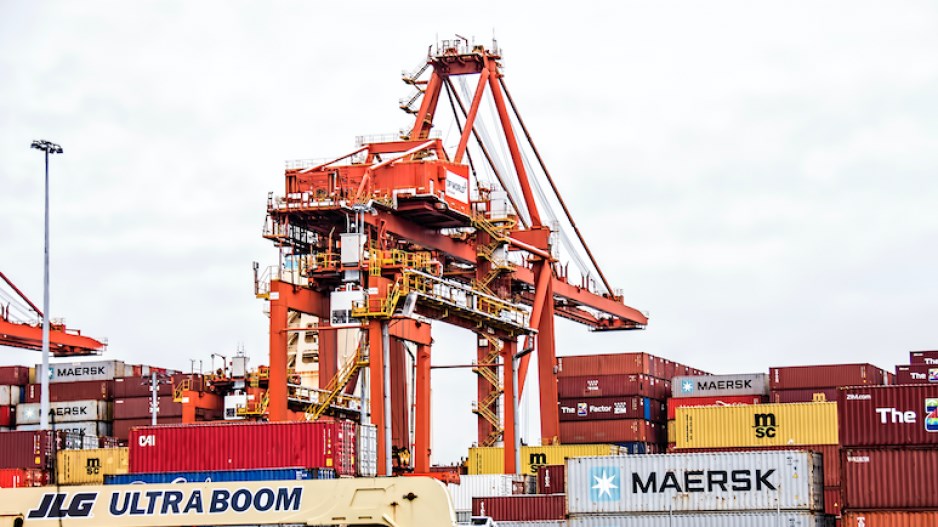Cargo congestion clouds are lifting along the West Coast, but don’t expect clear skies anytime soon.
That’s one of the takeaways from two recent analyses of transpacific freight movement, and it’s an outlook that provides glimmers of optimism for West Coast North American port operations, which the World Bank earlier this year ranked at the bottom of global port efficiency ratings.
In its most recent ports and terminals briefing, Drewry noted that U.S. ports remain heavily congested, but, added Eleanor Hadland, senior analyst in the U.K.-based global shipping consultancy’s ports and terminals practice, “we are starting to see some signs of improvement on the West Coast.”
Drewry data showed average port-call duration (APCD) for ships at West Coast North American container cargo terminals peaking at more than seven days in October 2021, which Hadland said was more than 300 per cent higher than pre-pandemic 2019’s APCD.
She added that, while the sharp upward spike in the time container ships were forced to spend at West Coast port terminals that began in 2020’s fourth quarter remains high, “we've seen early signs of improvement in L.A. and Long Beach, [and] 91ԭ�� is pretty much back to normal.”
That might be good news for container terminal operators and terminal productivity. For the rest of the supply chain, however, the news is less upbeat.
Hadland pointed out that increased port terminal efficiency has shifted cargo bottlenecks further along the supply chain to warehouses, distribution centres and truck chassis.
“So, boxes may be moving through the terminal slightly quicker, but, overall, the supply chain is still not keeping up with demand.”
The growth in global container port cargo throughput in 2022’s first quarter, according to Drewry data, was 3.3 per cent, which is up from 2.1 per cent in 2021’s first quarter but well below the 7.7 per cent recorded in 2021’s third quarter.
West Coast North American port efficiency in handling the boom in transpacific container traffic over the past three years has not been good, according to the Container Port Performance Index (CPPI), an annual measurement of container port efficiency produced by the World Bank in co-operation with S&P Global Market Intelligence.
As previously reported in Business in 91ԭ��, the most recently released CPPI ranked West Coast North American ports at the bottom of the efficiency index of 370 major ports around the world.
However, the 91ԭ�� Fraser Port Authority (VFPA) pointed out that this year’s CPPI report reflected “an analysis of a unique point in time that includes impacts from last summer’s wildfires in B.C. and the severe flooding in November.”
That combination, according to the VFPA statement, cut the Port of 91ԭ�� off from national supply chains entirely for eight days and partially for an additional nine days.
The VFPA added that 91ԭ�� and all West Coast ports were affected by the surge in North American demand for imports from Asia that began in late 2020 and resulted in the significant congestion and delays that began in 2021 and have spilled over into 2022.
Widespread port congestion and the spike in North America’s demand for consumer goods that began in 2020’s second half have resulted in far more than customer inconvenience and supply chain disruption.
Consider, for example, that transpacific container shipping rates for a 40-foot-equivalent unit (FEU) that hovered around US$1,700 in January 2019 were closer to US$20,000 in January 2022.
When you factor in the average value of what is carried in a container at around US$45,000, shipping costs are taking a large bite out of profit margins for shippers and retailers – no matter how large they are.
According to Sea Intelligence, shippers alone have lost between US$5 billion and US$10 billion over the past two years because of vessel delays. The estimate from the Denmark-based supply chain analytics company does not include port congestion or inland transportation delays.
The immediate costs of those supply chain complications are already evident at retail checkout counters; their long-term inflationary impacts have yet to be tallied.
However, there could be a silver lining for consumers in the unprecedented disruption to global trade and major supply chains sparked by the COVID-19 pandemic and exacerbated by Russia’s invasion of Ukraine.
Dan Gardner, the president and co-founder of Los Angeles-based Trade Facilitators Inc., said major retailers are also navigating uncharted waters when it comes to inventory allocation and ordering. Anticipating demand and securing space on container ships is an inexact science at any time. In today’s environment of economic volatility and supply chain dysfunction, it has become a high-stake guessing game.
High demand for space on container ships, Gardner said, will likely continue through to at least the end of the year.
“Who’s to say? … [because] no one knows what’s going to happen next month, never mind next spring.”
So, retailers that stockpiled inventory at the beginning of 2022 in anticipation of ongoing supply chain complications and high demand, might have over-estimated the strength of that demand as they shift from a just-in-time to a just-in-case inventory game plan.
Speaking at the Journal of Commerce’s recent top 100 U.S. importers panel discussion, Gardner pointed out that inventory levels for major retailers in the U.S. were up 15 per cent in April compared with the same time last year. With consumer demand increasingly shifting to travel and other service industry options and away from retail goods, he said, discounts could be on the horizon.
“Because companies sometimes overreact, … [they] buy too much [or] don’t buy enough. It’s the Goldilocks syndrome, right? You can never get the porridge just right. Sometimes it’s too cold and [that is] understandable in a highly disruptive global supply chain, [so] get ready to go to Marshalls and TJ Maxx and Burlington, because they’re going to have some deals. I guarantee you that.”



